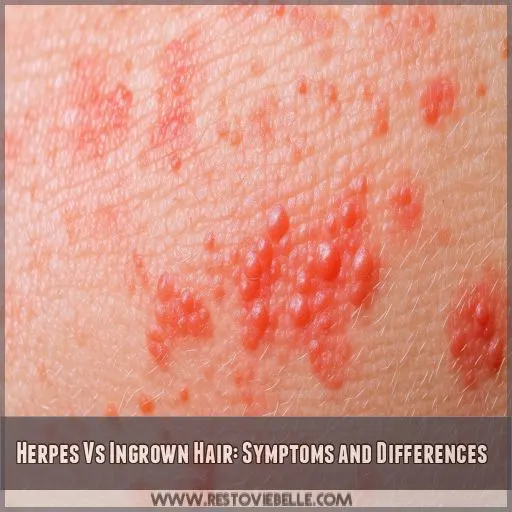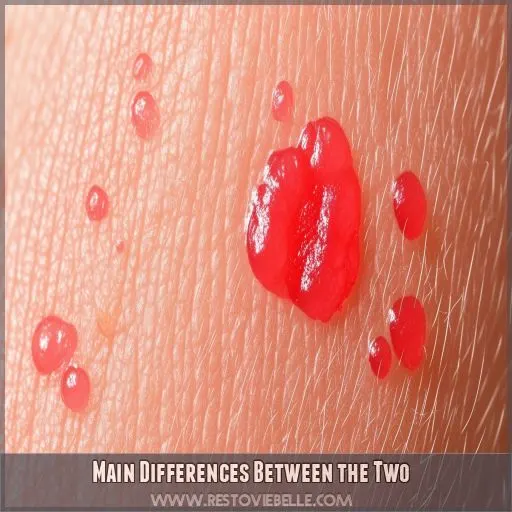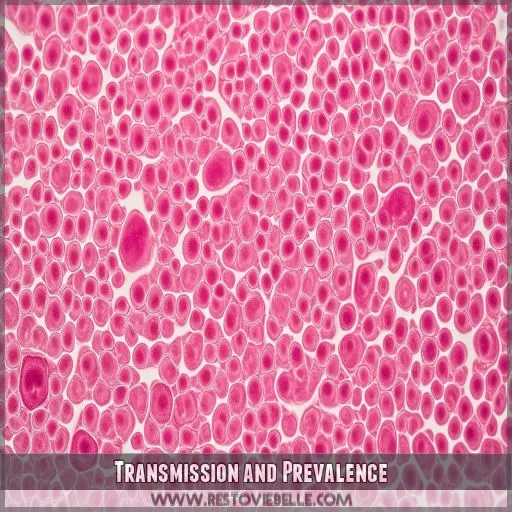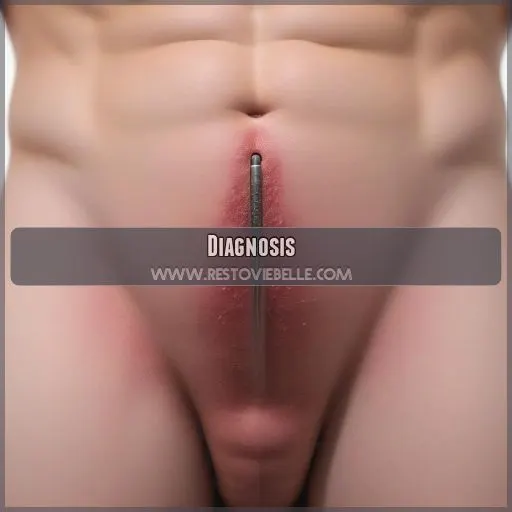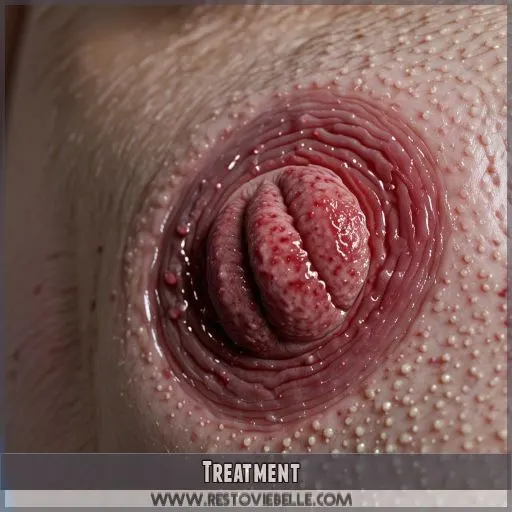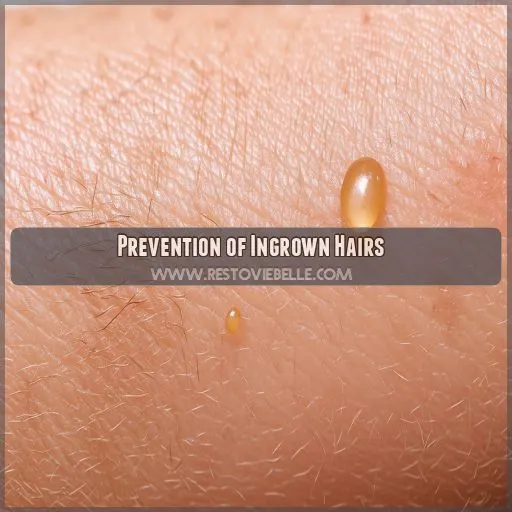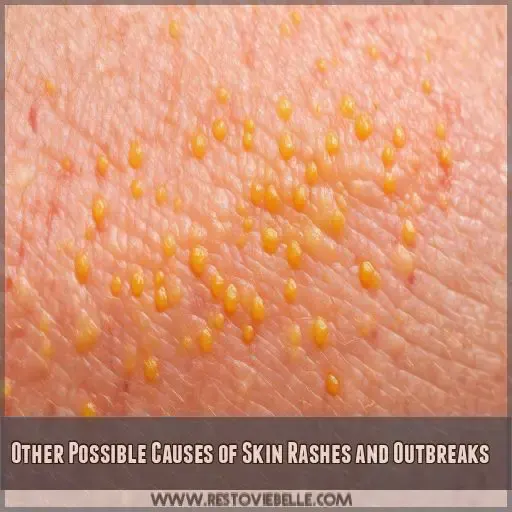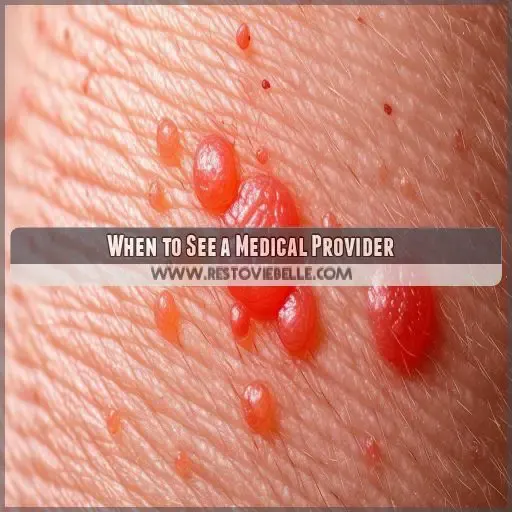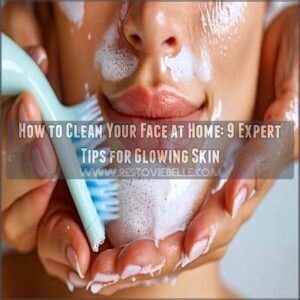This site is supported by our readers. We may earn a commission, at no cost to you, if you purchase through links.
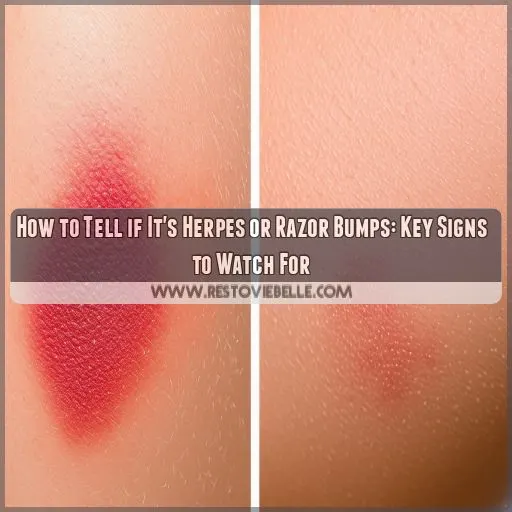 Wondering how to tell if it’s herpes or razor bumps? Look for key differences.
Wondering how to tell if it’s herpes or razor bumps? Look for key differences.
Herpes typically appears as clusters of small, painful blisters on one side of the genitals, developing 2-12 days after exposure. Herpes sores last longer (2-4 weeks) and require medical attention. Herpes is contagious and affects 1 in 5 American adults.
Razor bumps, or ingrown hairs, are usually isolated red bumps that pop up within a day or two of shaving. Ingrown hairs resolve quicker and can often be managed at home. They aren’t spreadable and occur in up to 60% of regular shavers.
If you’re still unsure, there’s more to uncover about these pesky skin troubles.
Table Of Contents
- Key Takeaways
- How to Tell if It’s Herpes or Razor Bumps?
- Herpes Vs Ingrown Hair: Symptoms and Differences
- Main Differences Between the Two
- Transmission and Prevalence
- Diagnosis
- Treatment
- Prevention of Ingrown Hairs
- Other Possible Causes of Skin Rashes and Outbreaks
- When to See a Medical Provider
- Frequently Asked Questions (FAQs)
- Does herpes feel like razor bumps?
- How can you tell if a bump is herpes?
- How do I know if I have razor bumps or STDs?
- How can you tell the difference between herpes and hair bumps?
- Can stress trigger herpes outbreaks or ingrown hairs?
- Are certain body areas more prone to herpes or razor bumps?
- How long after exposure can herpes symptoms appear?
- Can ingrown hairs become infected and mimic herpes symptoms?
- Do herpes or ingrown hairs affect people of all skin types?
- Conclusion
Key Takeaways
- If you’re scratching your head wondering if you’ve got herpes or razor bumps, pay attention to the timing. Herpes takes its sweet time, showing up 2-12 days after exposure, while razor bumps pop up within a day or two of shaving.
- Herpes likes to party in clusters, forming painful blisters that just won’t quit. Razor bumps, on the other hand, are more like solo acts, appearing as isolated red bumps.
- Herpes is a bit of a drama queen, sticking around for 2-4 weeks and requiring medical attention. Razor bumps are more like fleeting flings, resolving quickly and often responding to some TLC at home.
- If you’re still stumped, don’t be shy about seeking medical advice. Herpes is a sexually transmitted infection that needs proper treatment, while razor bumps can usually be handled with some home remedies.
How to Tell if It’s Herpes or Razor Bumps?
To tell if it’s herpes or razor bumps, check for painful blisters or sores typical of herpes, versus red, irritated bumps from shaving. Herpes often includes flu-like symptoms, while razor bumps do not.
Herpes Vs Ingrown Hair: Symptoms and Differences
To distinguish between herpes and razor bumps, you’ll need to know the key symptoms of each condition. Herpes typically causes clusters of small, painful blisters, while ingrown hairs often appear as isolated, red bumps with a visible hair trapped underneath the skin.
Herpes Simplex Virus (HSV-1 and HSV-2) Symptoms
Herpes simplex virus (HSV) can cause both oral and genital herpes. You’ll want to watch for these key symptoms:
- Cluster of small, blister-like sores
- Bumps smaller than 2 millimeters
- Repeated outbreaks over time
- Yellow discharge
- Tender, painful sores
These signs often indicate HSV-1 or HSV-2 infection. While there’s no cure, antiviral treatment can help manage symptoms and reduce transmission risk. Remember, genital herpes affects about 1 in 8 people aged 14-49 in the US.
Ingrown Hair Symptoms
Ingrown hairs can be pesky intruders, causing discomfort and confusion. Here are four key symptoms to watch for:
- Isolated, small red bumps
- Pimple-like heads on affected areas
- Itching and tenderness around the bumps
- Visible hair growing beneath the skin’s surface
These razor bumps often appear within 1-2 days after shaving. While they’re generally harmless, ingrown hairs can sometimes become infected, leading to more severe symptoms. Prevention is key, but if you’re prone to outbreaks, consider alternative hair removal methods or ingrown hair treatments.
Main Differences Between the Two
Now that we’ve covered the symptoms, let’s explore the key differences between herpes and razor bumps. Distinguishing between the two can be challenging, but certain indicators can help:
- Location: Herpes typically manifests on one side of the genitals, while razor bumps can surface anywhere you’ve shaved.
- Timing: Herpes sores develop within 2-12 days of exposure, whereas razor bumps appear within 1-2 days of shaving.
- Appearance: Herpes causes clusters of small blisters, while razor bumps are often solitary and resemble pimples.
You’ll notice herpes blisters persist longer, lasting 2-4 weeks. Razor bumps, in contrast, tend to resolve more quickly. If you observe a hair growing beneath the skin, it’s likely an ingrown hair rather than herpes. Remember, sexually transmitted infections like herpes require medical attention, while razor burn treatment can often be managed at home.
Transmission and Prevalence
Understanding the transmission and prevalence of herpes and razor bumps is of utmost importance for your sexual health. While razor bumps aren’t contagious, herpes spreads through unprotected sex and skin-to-skin contact. Your immune system plays a role in both conditions, affecting recurrent outbreaks and healing.
Here’s a quick breakdown of prevalence and transmission:
- Herpes affects 1 in 5 American adults, with prevalence by age increasing.
- Razor bumps occur in up to 60% of people who shave regularly.
- Transmission risk reduction for herpes includes using protection and antiviral medications.
- Razor bumps aren’t transmissible but can be exacerbated by poor shaving techniques.
Diagnosis
If you’re unsure whether your symptoms indicate herpes or razor bumps, a healthcare provider can perform diagnostic tests for accurate identification. These may include a blood test for HSV antibodies or an STI screening to rule out other potential causes of your symptoms.
Blood Test for HSV
If you’re unsure whether it’s herpes or razor bumps, a blood test for HSV can provide clarity. This test detects antibodies your body produces to fight the virus. It’s particularly useful for HSV diagnosis when you don’t have visible symptoms.
Discuss with your doctor to understand your results and next steps.
STI Screening Test to Rule Out Other Causes
If you’re unsure about your symptoms, an STI screening can help rule out other causes. This thorough test checks for various sexually transmitted infections, not just herpes. Here’s what you can expect:
- Blood tests for HIV, syphilis, and hepatitis
- Urine tests for chlamydia and gonorrhea
- Swab tests for specific areas of concern
- Physical examination by a healthcare provider
STI screenings provide peace of mind and guarantee you’re getting the right treatment for your symptoms.
Treatment
Treatment for herpes and ingrown hairs differs markedly. For herpes, your doctor may prescribe antiviral medications to suppress outbreaks and manage symptoms, while ingrown hairs typically resolve on their own without medical intervention.
Herpes Treatment
If you’ve been diagnosed with herpes, don’t panic. While there’s no cure, antiviral medications can help manage outbreaks and reduce transmission risk. Your doctor may prescribe:
- Daily suppressive therapy to prevent outbreaks
- Episodic treatment to shorten outbreak duration
- Pain relief medications for symptom management
Ingrown Hair Treatment
For ingrown hair treatment, you’ve got options:
- Let it heal naturally – most cases resolve on their own.
- Apply a warm compress to soothe and encourage the hair to surface.
- Gently exfoliate to remove dead skin cells blocking the hair’s path.
If symptoms persist, your doctor might prescribe retinoid cream or steroids to reduce inflammation. In severe cases, oral antibiotics may be necessary. Remember, prevention is key – proper shaving techniques and regular exfoliation can help avoid future ingrown hairs.
Prevention of Ingrown Hairs
Preventing ingrown hairs is key to avoiding those pesky razor bumps. You can take several steps to reduce your risk:
- Exfoliate before shaving to remove dead skin cells and unclog pores
- Use a clean, sharp razor to achieve a smooth shave
- Pull your skin taut while shaving to create a flat surface
- Apply over-the-counter lotions to soothe and moisturize after hair removal
When shaving, always go with the grain of your hair growth. This might mean shaving in different directions on various parts of your body. Don’t rush the process – take your time to avoid nicks and cuts. If you’re prone to ingrown hairs, consider alternative hair removal methods or even embracing your natural hair. Remember, everyone’s skin is different, so what works for your friend mightn’t work for you. Experiment with these techniques to find your perfect hair removal routine.
Other Possible Causes of Skin Rashes and Outbreaks
While herpes and razor bumps are common culprits, other conditions can cause similar skin issues. Skin allergies, irritants, fungal or bacterial infections, and autoimmune conditions might also lead to rashes or outbreaks, making it imperative to consult a healthcare provider for an accurate diagnosis.
Skin Allergies And Irritants
While preventing ingrown hairs is imperative, other skin issues can mimic herpes or razor bumps. You might be dealing with skin allergies or irritants. These can cause rashes that look similar to herpes or razor burn. Common culprits include harsh soaps, fragrances, or even certain fabrics.
Fungal Or Bacterial Infections
Besides skin allergies and irritants, fungal or bacterial infections can also cause rashes that mimic herpes or razor bumps. You might notice redness, itching, or unusual discharge. These infections often respond to specific treatments, so it’s essential to get an accurate diagnosis from your healthcare provider.
Autoimmune Skin Conditions
Autoimmune skin conditions can mimic herpes or razor bumps. These disorders, like psoriasis or lupus, occur when your immune system attacks healthy skin cells. Symptoms may include rashes, blisters, or sores. Treatment often involves managing inflammation, while prevention focuses on identifying and avoiding triggers that worsen symptoms.
When to See a Medical Provider
While many skin issues resolve on their own, there are times when you should seek medical attention. Don’t hesitate to visit urgent care or your healthcare provider if you experience:
- Severe pain or discomfort that interferes with daily activities
- Worsening symptoms that don’t improve with home remedies
- Fever or chills, which may indicate an infection
If you’re concerned about a possible sexually transmitted infection, it’s important to get tested. Remember, early detection and treatment can prevent complications and reduce transmission risk.
Keep an eye out for unusual discharge, persistent itching, or sores that don’t heal. These could be signs of something more serious than razor bumps. When in doubt, it’s always better to err on the side of caution and consult a medical professional. They can provide an accurate diagnosis and appropriate treatment, giving you peace of mind.
Frequently Asked Questions (FAQs)
Does herpes feel like razor bumps?
Herpes and razor bumps feel different. You’ll notice herpes causes painful blisters that recur, while razor bumps are temporary, itchy red bumps. Herpes sores often cluster and ooze, but razor bumps are isolated and may have visible hairs.
How can you tell if a bump is herpes?
With 1 in 8 adults having genital herpes, it’s essential to identify symptoms. You’ll notice herpes bumps are clustered, blister-like sores that recur and may ooze. They’re typically painful, smaller than 2mm, and appear 2-12 days after exposure.
How do I know if I have razor bumps or STDs?
You’ll need to examine the bumps closely. Razor bumps are usually red and appear shortly after shaving. STDs like herpes often cause clusters of painful blisters. If you’re unsure, it’s best to see a doctor for proper diagnosis.
How can you tell the difference between herpes and hair bumps?
Coincidentally, you’re not alone in this dilemma. Herpes typically presents as clusters of painful blisters, while razor bumps are isolated and pimple-like. Herpes recurs and may have yellow discharge, whereas razor bumps often disappear after hair regrowth.
Can stress trigger herpes outbreaks or ingrown hairs?
Yes, stress can trigger herpes outbreaks by weakening your immune system. While it doesn’t directly cause ingrown hairs, stress-related habits like rushed shaving or neglecting skincare can increase your risk of developing them. Managing stress benefits overall health.
Are certain body areas more prone to herpes or razor bumps?
Imagine Lisa’s frustration with recurring bumps. You’re not alone. Herpes prefers moist areas like genitals and mouth, while razor bumps target shaved regions. Your pubic area, face, and legs are common spots for both. Understanding these patterns aids prevention.
How long after exposure can herpes symptoms appear?
Herpes symptoms typically appear 2-12 days after exposure. You may notice painful blisters or ulcers developing during this period. If you’re uncertain, seeking medical advice for accurate diagnosis and guidance can be important.
Can ingrown hairs become infected and mimic herpes symptoms?
Yes, ingrown hairs can become infected and mimic herpes symptoms by causing painful, red bumps. However, unlike herpes, they often have visible hair trapped under the skin and typically appear shortly after shaving.
Do herpes or ingrown hairs affect people of all skin types?
Herpes and ingrown hairs can affect people of all skin types. While herpes is a lifelong viral infection, ingrown hairs are a temporary skin irritation that often clears up on their own. Seek medical advice to properly diagnose your condition.
Conclusion
When deciphering whether it’s herpes or razor bumps, remember these key signs. Herpes, a viral infection, manifests with long-lasting, painful sores and needs medical intervention. Razor bumps, merely ingrown hairs, resolve quickly and aren’t contagious. Understanding these distinctions is necessary for proper care.
If uncertain, seek medical advice, especially for herpes. Knowing how to distinguish herpes from razor bumps ensures you receive the right treatment and maintain your health effectively.

